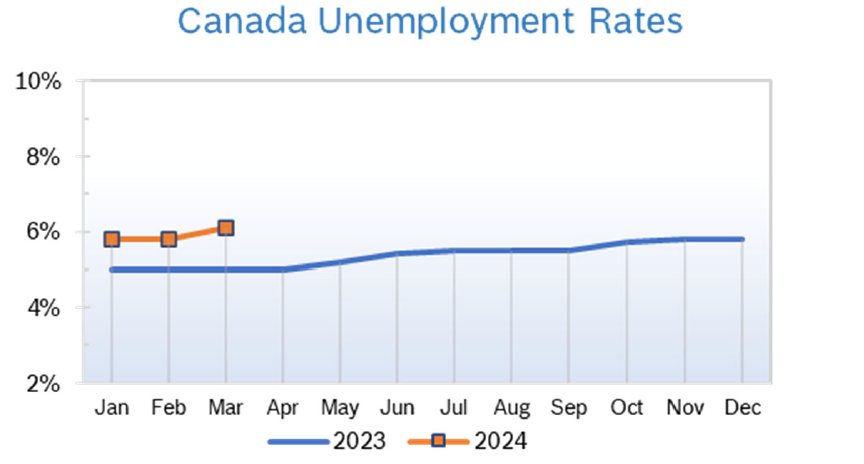|
Unemployment Rises to 6.1% in March
Consumer Prices Rise 2.9% Consumer prices rose 2.9% year over year in March after rising 2.8% year over year in February, in line with expectations. Prices for services continued to rise, climbing 4.5% in March compared with February's 4.2% increase. The price of goods increased just 1.1%. On a monthly basis, the CPI rose 0.6% in March. Core CPI continued to slow, falling to 3.1% in March and was up 2.8% year over year, according to Statistics Canada. On a monthly basis, consumer prices rose 0.6% in March. Underlying price pressures eased despite the slight tick up, causing economists to confirm expectations for an interest rate cut in June. Housing and Construction News Housing starts fell 7% in March to 242,195 seasonally adjusted annual units after rising to 260,047 in February, according to Canada Mortgage and Housing Corp. (CMHC). Monthly numbers can be skewed by big swings in multi-unit starts. To smooth out those swings and give a clearer picture of the upcoming housing supply trend, CMHC also reports a six-month moving average of the adjusted rate. In March, that indicator 243,957 starts, down 1.6% from 247,971 in February. Canadian home sales were up 0.5% in March from February numbers and were up 1.7% year over year, according to the Canadian Real Estate Association (CREA). After five months of declines, prices held steady at C$698,530, up 2% from February. In its updated outlook for the year, CREA says it now expects 492,083 homes to be sold this year, a 10.5% increase from 2023.The national average home price is also forecast to climb 4.9% on an annual basis to C$710,468 in 2024. Canadian housing starts are expected to decline for the third consecutive year in 2024 as elevated borrowing costs make projects less attractive to homebuilders, according to The Canadian Mortgage and Housing Corporation (CMHC). They forecast that starts will fall to 224,485 units this year from 240,267 in 2023. Starts are then forecast to rise in 2025 and 2026 but stop short of the 2021 peak of 271,198. Existing home prices and sales are expected to rise this year and could reach the peak levels recorded in early 2022 by 2025 and surpass them in 2026, driven by high demand but sales may be depressed as prospective buyers deal with affordability challenges. The BoC raised their forecast for Canadian growth this year to 1.5% from an earlier estimate of 0.8%, primarily because of expectations that exports will greatly exceed imports. Policymakers noted that export numbers will also get a boost from the Trans Mountain pipeline expansion, which will start shipping oil to the Pacific coast on May 1. They also raised their outlook for US growth to 2.7% in 2024 and 1.8% in 2025, up from 1.7% and 1.2% previously. GDP Rises 0.2% Real GDP increased 0.2% in February after rising a downwardly revised 0.5% in January. Services-producing industries grew 0.2%, leading the growth for a second consecutive month, fueled by gains in transportation and warehousing. The goods-producing industries aggregate was essentially unchanged. Overall, 10 of 20 sectors increased in February. Interest Rates Steady The Bank of Canada (BoC) held interest rates steady at 5% for the sixth consecutive time at their meeting in early April. The decision was widely expected because core inflation has remained stubbornly above the Bank’s 2% target rate. However, the central bankers were divided as to when to start lowering rates, with some believing the BoC should take its time lowering rates to make sure inflation continues to trend down and other feeling rates should be cut soon. They hinted that a rate cut in June was still a possibility. The BoC started raising rates in 2022, which forced many potential homebuyers to the sidelines and caused prices to fall. Retail Sales Drop 0.1% Retail sales decreased 0.1% in February to $66.7 billion after dropping to $67.0 billion in January. Sales were down in five of nine subsectors and were led by a 2.2% drop in sales at gasoline stations and fuel vendors. Core retail sales, which exclude gasoline stations and fuel vendors and motor vehicle and parts dealers, were unchanged in February. In volume terms, retail sales decreased 0.3% in February. General merchandise sales were the biggest contributor to sales but sales at building material and garden equipment and supplies dealers fell 0.4%. Retail sales fell in seven provinces in February but were up 1.2% in British Columbia. Retail Ecommerce Sales Rise 1.9% Retail ecommerce sales rose 1.9% in February to $3.8 billion, accounting for 5.7% of total retail trade, up from 5.6% in January. Retail Notes Canadian Tire stock has slumped 28% since last July and is now trading at levels seen five years ago. Last year, revenue fell 6.5%. Fourth quarter revenue was down 16.8% compared to 2022. Net profit shrank to $339.1 million in 2023, down from $1.18 billion in the previous year. CEO Greg Hicks said the year was more challenging than expected, due to rising interest rates, stubborn inflation that impacted discretionary spending and bad weather. Weather may have hit Canadian Tire harder than rivals, since they carry a heavy inventory of winter equipment and goods. Analysts noted that the slump was due to an overall slump in the retail market not poor management or decision making. © Robert Bosch Tool Corporation. All rights reserved, no copying or reproducing is permitted without prior written approval.
Comments are closed.
|
Archives
July 2024
|








